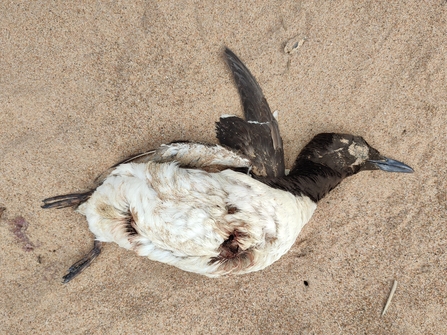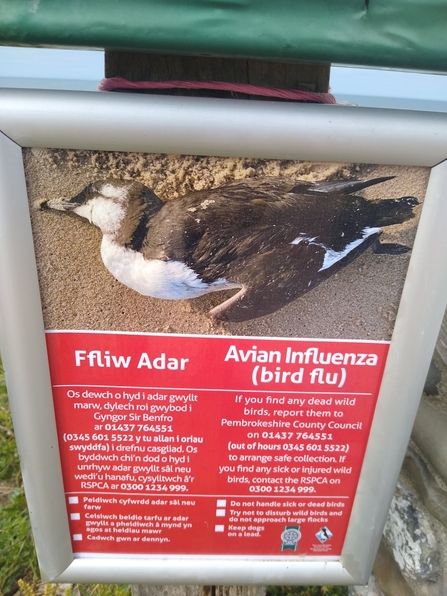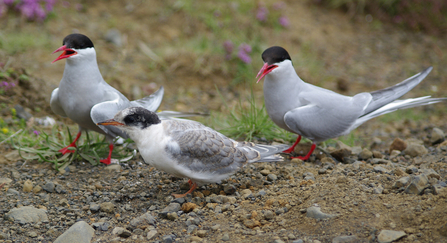I’ve been lucky enough to be able to watch a colony of Guillemots and Razorbills close to where I live on the Pembrokeshire cliffs during this spring and summer. Crammed onto the cliff ledges, nooks, and crannies, they spend a few frantic months raising their chicks on ledges, often high up on the cliffs. Constantly squabbling with their neighbours, the whole colony is alive with their incessant calls. The birds constantly come and go as they feed in the surrounding coastal waters and bring food, mainly sand eels, back for their chicks. When the chicks are old enough, they are encouraged to jump off their ledges into the sea by their parents calling below. I was incredibly fortunate to see this firsthand on a warm July evening this year, and once in the water, the chick swims off to a parent, where it will spend the winter months at sea. As I watched this one young chick disappear with its parent as it headed out to sea, I was left wondering what the future held for this bird that would not start to breed until it was four years old. Guillemots along with many of our seabirds, lead extremely precarious lives and face many challenges. One of these is avian flu, a deadly disease that continues to have a devastating effect on our seabirds across the UK and here in Wales.
Bird Flu tragedy continues to seriously impact our Seabirds across the UK and Wales

Dead Guillemot ©Jenny Aitchinson
It is a disease that has not gone away and is not getting the urgent attention it deserves from the UK Government and Welsh Government. It only occasionally gets picked up by the media. Let’s be under no illusion this disease has already had a massive impact on seabirds in the UK and Wales, and this year was no different. Given the UK’s international importance for seabirds this is especially concerning.
Avian flu is caused by the H5N1 virus and is believed to have originated from factory-farmed poultry farms. Large numbers of birds kept in confined conditions are the ideal breeding ground for the virus, which spreads through infected faeces, saliva or nasal secretions.

Bird Flu sign in Sir Benfro © Tim Birch
The Royal Society for the Protection of Birds recently made a shocking announcement that the 3rd largest colony of Gannets in the UK at Grassholm off the Pembrokeshire coast had suffered a huge population crash this year due to avian flu. A survey from July 2023 shows a 52% reduction in breeding birds with 16,482 pairs recorded this year compared to 34,991 pairs in 2022.
Recently, hundreds of dead Guillemots were washed up dead on the beaches of south Pembrokeshire and confirmed as having avian flu. On one beach alone, a total of 201 birds were picked up, with over 1,000 dead birds recorded across the region. Yet it is believed this may be the tip of the iceberg of the true scale of the birds that have died. I was left wondering if any of the Guillemots I had watched continually over the summer months had fallen victim to this disease.
Pembrokeshire has some of the most important seabird breeding colonies in the UK and internationally. The islands of Skokholm and Skomer, which are managed by the South and West Wales Wildlife Trust, are home each year to hundreds of thousands of puffins, manx shearwaters, guillemot, razorbills and kittiwakes. The ongoing risk to the seabirds of these islands from avian flu is extremely serious and could be potentially devastating.
At one site alone in Cemlyn Bay on Anglesey, managed by North Wales Wildlife Trust, over 1,200 birds were collected during this year’s summer breeding season. Of these dead birds, 711 were sandwich terns and most were chicks, accounting for almost half of the chicks that hatched. This site is one of the most important in the UK for sandwich terns, which migrate here from Africa in April before returning south in the early autumn. The Cemlyn bird colony managed to avoid the impact of bird flu last year, but no such luck this year, sadly.
Other species, such as arctic and common terns, also suffered huge losses at our nature reserve at Cemlyn Bay, which was distressing for visitors, wardens, and volunteers who work at this site. These species face a constant battle yearly with their tremendous hazardous migrations from Africa and Antarctica to return to sites such as Cemlyn to breed. Once here they continue to face constant pressures from predators such as foxes and birds of prey, storms, overfishing, pollution and increasing extreme weather events from climate change and human disturbance.
Bird flu is another significant pressure our seabirds now face, which has the potential to deliver severe long-term impacts on the populations of these birds across the UK and Wales. This combined with all the additional pressures, means that our seabirds are facing unprecedented times, and their future is far from certain. Entire populations of seabirds, both in Wales and across the UK could be lost, which is an extremely worrying prospect.

Arctic terns © Gillian Day
The National Trust, who we work with very closely at Cemlyn Bay, recently sadly announced that over 7,000 seabirds had died this year at a number of their most important sites for seabirds across the UK, which included Wales. This follows last year when over 6,000 birds died.
What is clear is that avian bird flu is still present in our seabirds and that the risks to these internationally important bird populations are immense. The Welsh Government says it will be publishing a strategy for seabird recovery next year, but we need action now to be put in place and ahead of the return of our seabirds to their breeding colonies in 2024.
Tackling the problem is understandably challenging but there are a number of key areas where action can be taken. This action is urgently needed as our internationally important seabird populations are under serious threat.
What are the Wildlife Trusts calling for?
We need the UK and Welsh Governments to:
- Start effective and co-ordinated monitoring, surveillance, research and reporting systems so that we have an accurate real-time understanding of the virus and its progress in our seabirds.
- Provide resources and equipment, such as protective clothing and adequate disposal facilities, to help remove and dispose of dead birds, which is vital to help reduce the risk of transmission.
- Ensure that there is ongoing clear and consistent public messaging so that people know not to touch sick or dead birds.
- Invest in research into how and why avian bird flu is happening to help avoid ongoing similar tragedies happening in 2024 and beyond.
- It is vital that resilience is built up in our seabird populations in the UK and Wales. We urgently need recovery and conservation measures put in place. This includes avoiding damaging development at sea, reducing seabirds killed in bycatch through fishing activities, adopting sustainable fisheries practices and reducing human disturbance of all forms.
- Marine Protect Areas need to be effectively managed, and the establishment of Fully Protected Marine Areas is urgently needed to provide areas of sanctuary for our remaining seabird populations.
If you find a dead seabird do not touch or pick up any dead or visibly sick seabird that you may find on a beach or on the coast. Sick or injured seabirds on public land should be reported to the RSPCA on 03001234 999.
You can call the DEFRA helpline 03459 33 55 77, or go to the website on the link below:





